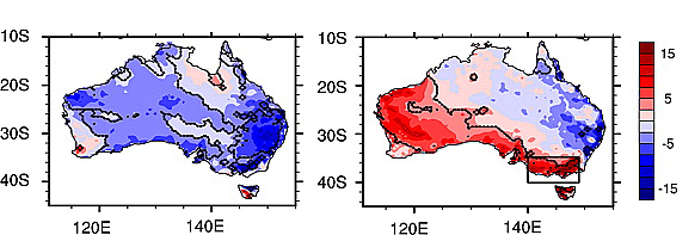Climate oscillations are weather cycles, where atmospheric or oceanic conditions, such as sea surface temperature (SST) or atmospheric pressure, fluctuate regularly. These fluctuations are often related to changes in temperature and precipitation patterns even far away, through so-called teleconnections. The most studied climate oscillation is the El Niño Southern Oscillation (ENSO), which originates in the Pacific Ocean, and is the most significant driver of global climate variability.
Another major climate oscillation, the Indian Ocean Dipole (IOD), originates from the Indian Ocean. In the IOD, surface water temperatures in the western and eastern parts of the Indian Ocean fluctuate regularly: during a positive IOD phase, warm SST anomalies appear in the western Indian Ocean, and colder than usual SSTs occur in the eastern parts, while during a negative phase the SST anomalies are opposite. The fluctuations of the IOD are known to have widespread impacts on precipitation in the areas surrounding the Indian Ocean – e.g. in East Africa, India and Indonesia.

Figure 1. Precipitation in Australia during positive (left) and negative (right) phases of the Indian Ocean Dipole (Ummenhofer et al. 2009).
The IOD has an especially strong impact on weather conditions in Australia (Figure 1), where the positive phase of the IOD has been related to the severest droughts of the 20thcentury. Since crop yields in Australia are heavily controlled by weather, the IOD also impacts Australia’s crop production. Recent research conducted in the Water and Development Research Group showed that the productivity of crops tends to be 8% below (6% above) average during the positive (negative) phase of the IOD.
Especially, wheat yields are shown to be impacted by the IOD, and around 40% of Australia’s wheat yield variability can be attributed to the IOD. Since Australia is responsible for around 10% of global wheat exports, utilizing information of the IOD could help maintain stability in the global wheat markets.
Intian valtameren dipolin vaikutukset Australian viljantuotantoon
Intian valtameren itä- ja länsiosissa esiintyvää ilmiötä, jossa pintaveden lämpötila vaihtelee säännöllisesti, kutsutaan nimellä Intian valtameren dipoli. Tämä vaihtelu vaikuttaa sadantaan Intian valtameren lähialueilla, mutta myös kauempana. Austaliassa Intian valtameren dipoli on yhdistetty 1900-luvun voimakkaimpiin kuivuusjaksoihin; kun dipoli on voimakkaassa vaiheessaan (länsiosissa lämmin, itäosissa kylmä), Australiassa sataa keskimäärin vähemmän. Nämä heilahtelut vaikuttavat myös viljasatoihin, ja Intian valtameren dipolin on osoitettu selittävän noin 40% Australian vehnäsatojen vaihtelusta. Koska Australia vastaa 10% maailman vehnän viennistä, Intian valtameren dipolista saatavan tiedon hyödyntäminen, voi auttaa ylläpitämään vakautta maailman vehnämarkkinoilla.
For more information:
Ummenhofer, Caroline C., et al. “What causes southeast Australia’s worst droughts?.” Geophysical Research Letters 36.4 (2009).
Yuan, Chaoxia, and Toshio Yamagata. “Impacts of IOD, ENSO and ENSO Modoki on the Australian winter wheat yields in recent decades.” Scientific reports 5 (2015): 17252.
Heino, Matias, et al. “Two-thirds of global cropland area impacted by climate oscillations.” Nature communications 9.1 (2018): 1257.

